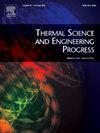采用四象限引脚翅片和多孔金属泡沫散热器的高浓度光伏(HCPV)布置的温度均匀性分析
IF 5.4
3区 工程技术
Q2 ENERGY & FUELS
引用次数: 0
摘要
高聚光光伏(HCPV)阵列的温度均匀性对系统的整体性能和寿命起着关键作用。本研究对低质量流量(50 g/min ~ 250 g/min)下,用于高浓度光伏(HCPV)系统的引脚翅片和多孔金属泡沫散热器的共轭传热、温度均匀性和性能特性进行了数值研究。研究表明,低孔隙率(ε = 0.6)的多孔金属泡沫散热器在多孔泡沫中的三种考虑情况(ε = 0.6、0.7和0.8)中始终具有优越的温度均匀性,并且在高质量流量下的压降较低。其中,当质量流量为250 g/min时,多孔金属泡沫(ε = 0.6)的平均温度为316.78 K,温度均匀性指数为2.5%。此外,多孔金属泡沫散热器在更高的努塞尔数和对流换热系数方面优于针翅片散热器,两者都与孔隙率成反比。多孔金属泡沫散热器(ε = 0.6)也表现出更高的性能评估标准(PEC),净功率增益在130 W至138 W之间。此外,这种配置实现了最高的太阳能电池和整体能源效率,分别达到42.32%和52%。因此,低孔隙率的多孔金属泡沫散热器被认为是当前研究的最佳解决方案,多孔金属泡沫散热器可以作为热管理和实现HCPV系统温度分布均匀的可行替代方案,因为它提供了优越的水热性能。本文章由计算机程序翻译,如有差异,请以英文原文为准。
Temperature uniformity analysis of high concentrated photovoltaics (HCPV) arrangement using four quadrant pin fin and porous metal foam heatsink
Temperature uniformity across the high-concentrated photovoltaics (HCPV) array plays a key role in the overall performance and longevity of the system. This study numerically investigates the conjugate heat transfer, temperature uniformity, and performance characteristics of pin fin and porous metal foam heatsinks for high-concentrated photovoltaic (HCPV) systems at low mass flow rates (50 g/min to 250 g/min). The study reveals that porous metal foam heatsinks with low porosity ( = 0.6) consistently provide superior temperature uniformity among the three considered case ( = 0.6, 0.7, and 0.8) in porous foam and a lower pressure drop at higher mass flow rates compared to pin–fin heatsinks. Specifically, the lowest average temperature (316.78 K) and temperature uniformity index (2.5 %) were achieved at a mass flow rate of 250 g/min for porous metal foam ( = 0.6). Furthermore, the porous metal foam heatsinks outperformed pin fin heatsinks in terms of higher Nusselt numbers and convective heat transfer coefficients, both of which are inversely proportional to porosity. The porous metal foam heatsinks ( = 0.6) also demonstrated higher performance evaluation criterion (PEC), with net power gain ranging from 130 W to 138 W. Additionally, this configuration achieved the highest solar cell and overall exergy efficiency, reaching 42.32 % and 52 %, respectively. As such, porous metal foam heatsinks with low porosity is identified as the optimal solution in the current investigation and the porous metal foam heatsinks can be a viable alternative for thermal management and achieving uniformity in temperature distribution for HCPV system as it provides superior hydrothermal performance.
求助全文
通过发布文献求助,成功后即可免费获取论文全文。
去求助
来源期刊

Thermal Science and Engineering Progress
Chemical Engineering-Fluid Flow and Transfer Processes
CiteScore
7.20
自引率
10.40%
发文量
327
审稿时长
41 days
期刊介绍:
Thermal Science and Engineering Progress (TSEP) publishes original, high-quality research articles that span activities ranging from fundamental scientific research and discussion of the more controversial thermodynamic theories, to developments in thermal engineering that are in many instances examples of the way scientists and engineers are addressing the challenges facing a growing population – smart cities and global warming – maximising thermodynamic efficiencies and minimising all heat losses. It is intended that these will be of current relevance and interest to industry, academia and other practitioners. It is evident that many specialised journals in thermal and, to some extent, in fluid disciplines tend to focus on topics that can be classified as fundamental in nature, or are ‘applied’ and near-market. Thermal Science and Engineering Progress will bridge the gap between these two areas, allowing authors to make an easy choice, should they or a journal editor feel that their papers are ‘out of scope’ when considering other journals. The range of topics covered by Thermal Science and Engineering Progress addresses the rapid rate of development being made in thermal transfer processes as they affect traditional fields, and important growth in the topical research areas of aerospace, thermal biological and medical systems, electronics and nano-technologies, renewable energy systems, food production (including agriculture), and the need to minimise man-made thermal impacts on climate change. Review articles on appropriate topics for TSEP are encouraged, although until TSEP is fully established, these will be limited in number. Before submitting such articles, please contact one of the Editors, or a member of the Editorial Advisory Board with an outline of your proposal and your expertise in the area of your review.
 求助内容:
求助内容: 应助结果提醒方式:
应助结果提醒方式:


